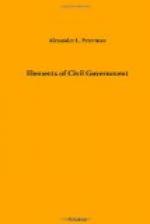A fourth form, namely, that of the individual ballot as used in the State of New Jersey, can not be here shown, as a separate ballot is required for each party or each independent nomination. These separate ballots are all official, and are furnished at public expense; but the use of an unofficial ballot is practically allowed, since the voter is permitted to take to the voting booth a paster ballot containing a complete party ticket, printed and furnished at party expense. This he can paste over the official ballot and deposit as his vote.
[Illustration 1: First form of ballot type: City Ballot—no party names, candidate names in alphabetic order.]
[Illustration 2: Second form of ballot type: Massachusetts Official Ballot.]
[Illustration 3: Third form of ballot type: Indiana State Ballot.]
SUGGESTIVE QUESTIONS.
1. What is meant by the Australian ballot system?
2. Name some places in the United States in which a similar system of reform has been adopted.
3. What are the essential principles of the system?
4. What are the necessary requirements for carrying out the law?
5. What is the object in providing official ballots?
6. Describe two kinds of polling booths used.
7. What are the obvious advantages of the reform?
8. Describe the characteristic forms of ballot used in various States which have adopted the reform.
9. Mention the advantages and the disadvantages of the city ballot shown on page 185.
10. Compare the Massachusetts ballot with the Indiana ballot, and note their differences.
QUESTION FOR DEBATE.
Which system of voting is likely to secure the best public officers: that represented in the city ballot of 1890, in the Massachusetts ballot, or in the Indiana ballot?
CHAPTER XX.
PARTIES AND PARTY MACHINERY.
Wherever the right to vote exists, the people naturally form themselves into political parties.
A political party is an organization of voters maintained for the purpose of impressing its principles upon the public policy of the country. Men have divers views as to the duties, scope, and proper measures of the government, and these divers views lead to the formation of opposing parties. In a free country the majority must rule, and parties are the means by which majorities are ascertained.
ORIGIN.—Parties usually grow out of questions of legislation, rather than out of questions of executive management or judicial interpretation. In other words, a party is formed to influence the passage of laws, rather than their execution or their application by the courts. But, when parties are once formed, they usually extend their influence to the selection of officers of all grades and all departments, even the least important officials of a township or civil district.




